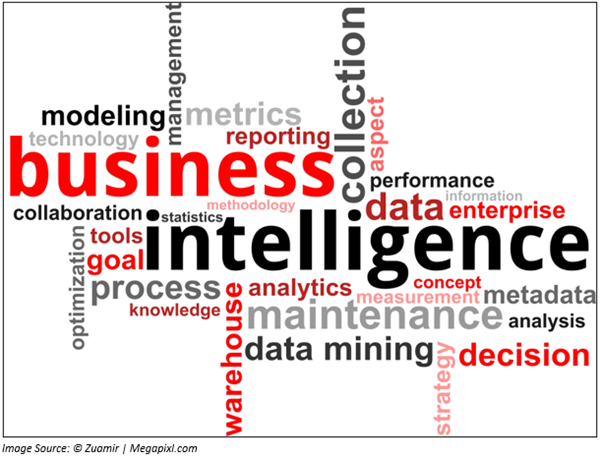What is Business Intelligence?
Business Intelligence (BI) is a technology-driven process to analyze data and provide actionable data to the management or people involved in decision making to take required steps. In the process of business intelligence, the companies collect data via internal as well as external sources. Then they prepare it for analysis, run queries and prepare data visualization, dashboards and reports for strategic planning and decision making on an operational front.

What is the goal of business intelligence?
The primary goal of business intelligence is to give the user the right performance information at an appropriate time using the right technology to make better decisions.
The data available these days is enormous. Using business intelligence and performance dashboards, one can derive meaningful outcome from these data, which is beneficial while taking any business-related decisions.
To achieve this goal, companies use various analytical tools, data management and reporting tools and several ways to deal and study data.
How does the process of business intelligence work?
The process of business intelligence follows mainly three steps.
- Collecting data and arranging it via reporting.
- Analyzing data
- Decision making.
Collecting data and arranging it via reporting:
The data refers to the raw data which the companies collect based on the day to day activities, product feedback, customer interaction, human resource management, operations, finance, marketing activities and many more. The data is stored in a data warehouse or the Company’s database.
Analyzing data:
Data analysis involves the processing of data to get a meaningful outcome. The user provides a command to contextualize the data and make it more meaningful and beneficial in achieving a business's strategic goals.
Decision making:
In most cases, BI projects fail because of the absence of strategic focus instead of faulty implementation. Business intelligence should be such that it allows the Company to lift the business to attain its strategic goal.
Hence BI has a critical role to play along with the management’s final decision to achieve the Company’s mission and vision.
What are the BI process steps for success?
To have a successful BI implementation, one should keep in mind a couple of points.
- Focus on the business problem before looking into the data. By doing so, you would be able to identify which data is relevant to the business problem.
- Define the requirement, objective, and scope of the business problem.
- The next step involves the stakeholder analysis and the data source. All stakeholders must be mobilized to ensure successful BI implementation. If this is not done and there is no commitment from the top management, BI could be a failure.
- Next comes the selection of the ideal BI tools. The user involved in the process must choose such BI tools that offer project customization possibilities and simple user experience.
- An essential step in the process is selecting the team that would carry out the process, as these people would be involved in validating the actions and certifying efficiency.
- Focus on the key performance indicators (KPI) as it shows the most important data for the business.
What are the Advantages and Disadvantages of BI?
Advantages:
- In present times, business intelligence has moved to the mobile platform, making it easy for the users to have the accessibility to the data at any point of time from any locations. It is possible because of the availability of BI tools on the cloud.
- Compared to the past when business intelligence reports were related only to report creation and spreadsheets, BI has become quite interactive with the upgradation of technology.
- It is possible to manage big data in real-time. The users now have access to the most recent and updated data.
- Through BI, it is possible to track a business’s KPIs and check whether they are met or not.
- Data visualization using BI tools can be carried out at a faster rate. Instead of comparing and contrasting figures on spreadsheets, users can look at the different data and figure out the actionable items.
- BI makes it easy for the users to understand the KPIs.
- It helps to improve productivity by supporting appropriate information.
Disadvantage:
- Though BI has made it possible to get more informed and efficient data, it may be possible that different users may have different conclusions from the same data.
- As data is collected from various sources, the biggest challenge here is related to data security. If the user uses mobile BI applications, then there is a possibility of getting personal data hacked.
- Another disadvantage of BI tools is that they are expensive. Hence it could be a challenge for a smaller firm to afford it.
- As there is abundant data available these days, the users may fetch those data which are irrelevant for them.
- In case there are irrelevant data, it may consume considerable time to get it resolved.
Applications of Business Intelligence
Business Intelligence has wide-scale applications. Some of the used cases where it is implemented include:
- Supervising business performance.
- Assist in decision making and making strategy.
- Assessing and improving the business processes.
- Detection of the trend, pattern, and the relationship between the various data points.
- Provide the key stakeholders with relevant data related to the customer, supply chain and various other business-related elements.
- In the finance industry, BI plays an essential role in assessing the risk of different financial products offered to the customers.
Some Popular BI tools
- QlikView
- IBM Cognos Analytics
- Looker
- Ad hoc analysis
- Online analytical processing
- Mobile BI
- Real-time BI
- Operational intelligence
- SaaS BI
- Open Source BI
- Embedded BI

 Please wait processing your request...
Please wait processing your request...